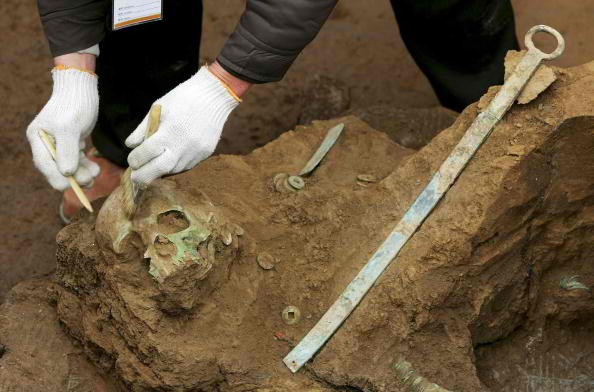Researchers have discovered more than a dozen cannabis plants in an ancient tomb in China, saying the unique find suggests that prehistoric central Eurasians had used the mind-altering plant for medicinal or ritualistic purposes.
In a recent paper published in Economic Botany, the scientists said an "extraordinary cache" of 13 "nearly whole" female cannabis plants were placed diagonally like the shroud over the remains of a man. The man was estimated to be 35 years old, appeared to be Caucasian, and might have been a shaman, they said.
In the tomb, the body was placed on a bed made with reeds and surrounded by earthenware pots. The plants measured 19 and 35 inches, and carbon dating indicated that the burial site is 2,800 to 2,400 years old.
"This is the first time ever that archaeologists have recovered complete cannabis plants, as well as the first incidence of their use as a 'shroud' or covering in a human burial," Hongen Jiang, the study's lead author, told the National Geographic.
Cannabis had been previously found at sites in Siberia and northwestern China, although the origins of the plants found at the sites were not clear and may have been transported from other areas. However, the researchers said that the way the plants were placed on the remains suggested they were fresh at the time and thus likely to be grown locally.
The tomb lies in northwest China's Turpan Basin, a desert oasis that served as "an important stop on the Silk Road," according to the National Geographic. It was found among 240 other tombs in the cemetery believed to the Subeixi people. As the study describes, the Subeixi, "led a pastoral life with only a small amount of cereal cultivation, but eventually developed a more balanced semi-pastoral and semi-agricultural society."
The researchers say there is mounting evidence that the Subeixi, along with other groups living in the area, used cannabis for ritualistic or medicinal purposes. Ten years ago, for instance, scientists unearthed "a large supply of processed female Cannabis flowers" at a Yanghai cemetery. The plants were likely selected because of their "psychoactivity, possibly to facilitate communication between the human and spirit worlds and/or for its medicinal value" as well as for being "an appetite stimulant"
Cannabis seeds were also recently discovered in a Siberian tomb of a woman who likely died of breast cancer and may have used the plant to "cope with the symptoms of her illnesses," the scientists said.
And while the plant can be made into fabric or used for its "nutritious, oil-rich seeds," Jiang said that "no hemp textiles have been found in Turpan burials, and the seeds of the plants in the Jiayi burial are too small to serve as a practical food source."
"Apparently, medicinal and possibly spiritual or at least ritualistic Cannabis use was a widespread custom among Central Eurasian peoples during the first millennium before the Christian era."



























